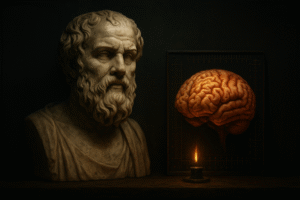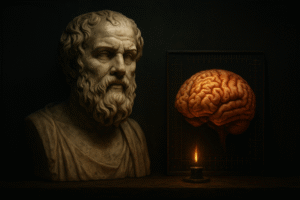
Introduction: Metaphors of Nature for Human Life
In the complex web of existence, we discover patterns and lessons that nature has wisely designed. One of the most captivating examples is the metamorphosis of the caterpillar into a butterfly, a process that goes beyond mere physical change and symbolizes a profound transformation. This metamorphosis, reflected in the richness of human experience, becomes especially evident in challenging times, where adversity becomes a catalyst for significant growth. Just like the caterpillar evolves into a winged being, we, when facing difficulties, have the opportunity to be reborn with renewed strength and vision. In this introduction, we lay the foundation for exploring how life’s challenges can propel our own rebirth, through the parallel between transformation in nature and human development.
“Nature does not hurry, yet everything is accomplished.” – Lao Tzu.

Metamorphosis and Growth: Parallels between Nature and Humanity
Addressing the fascinating metamorphosis of the caterpillar to butterfly, we delve into how this natural process serves as a metaphor for our personal growth and transformation. While the caterpillar begins its life in a limited environment, focused on basic survival, similarly we start our existence focused on elemental needs. The transition to the chrysalis represents a crucial period of transition and self-reflection, similar to moments of introspection and significant change in our lives. In these times, resembling the chrysalis, we are capable of reconfiguring our inner being, preparing ourselves for a rebirth. As the butterfly emerges, it symbolizes not just a physical change but the materialization of latent potential, a powerful metaphor for how, through our challenges and changes, we develop new abilities and perspectives. Thus, the metamorphosis of the caterpillar to butterfly becomes an inspiring analogy of our capacity to overcome obstacles and reach new horizons in our lives.
“In all things of nature there is something of the marvelous.” – Aristotle.

Crisis as Catalyst: Human Reflections of Natural Change
Our ‘dark nights of the soul’ are analogous to the caterpillar’s chrysalis. During these periods, we face challenges that shake our being, prompting us to reconsider our identity. This introspection, though uncomfortable, is essential for personal growth. Interestingly, research in positive psychology suggests that moments of adversity can act as catalysts for significant development. This process is called ‘posttraumatic growth,’ where individuals report an increase in resilience, stronger interpersonal relationships, and a greater appreciation of life after facing adverse situations. In our own emotional cocoon, we gestate a rebirth of our being.
“Adversity has the effect of eliciting talents which in prosperous circumstances would have lain dormant.” – Horace.

Encounters with the Dark Night of the Soul
This term, coined by the Spanish mystic Saint John of the Cross, describes a phase in life where we feel lost, disoriented, and disconnected. During these critical periods, our previous beliefs and perceptions disintegrate, which can result in a feeling of disorientation. However, studies have shown that these stages of ‘deconstruction’ are often followed by a period of psychological and spiritual reconstruction, where people find a renewed sense of purpose and direction. It is precisely in this chaos that we find the opportunity to transform ourselves radically. A study conducted by Columbia University found that people who go through a ‘dark night of the soul’ often experience a greater sense of well-being and satisfaction once they emerge from the process. Thus, we emerge from our dark night with renewed authenticity and understanding.
“The darkest night is often the bridge to the brightest tomorrow.” – Thomas Moore.

Narratives of Transformation: Inspiration through Real Stories
Around the world, stories of personal transformation span from historical figures to anonymous heroes. For example, consider Nelson Mandela, who, after 27 years in prison, emerged not with bitterness, but with a message of reconciliation and change. His story is a testament to the power of forgiveness and personal transformation. Similarly, Malala Yousafzai, after surviving an assassination attempt on her life for defending girls’ right to education, transformed into a global symbol of peaceful resistance and advocacy for education. These stories show us how extreme challenges can be catalysts for significant change and personal growth.
“True transformation occurs when we learn from our experiences and allow them to change our lives.” – Richard Branson.

Authenticity and Self-Acceptance: Pillars of a Renewed Self
Authenticity and self-acceptance are essential on the journey to a renewed self. A study from Harvard University revealed that people who can be authentic in their jobs are happier and more engaged. Another example is the practice of ‘self-compassion,’ which Dr. Kristin Neff has shown to be fundamental for positive mental health. Recognizing and accepting our weaknesses and fears, along with our strengths, frees us to live fuller and more authentic lives. Self-acceptance is not just feeling good about ourselves; it is also the first step towards deep and sustainable change.
“The privilege of a lifetime is to become who you truly are.” – Joseph Campbell.
Conclusion: Resilience and Renewal in the Journey of Life
The transformation of the caterpillar into a butterfly is not just a biological miracle but also a powerful symbol of our own capacity for change. Every year, monarch butterflies undertake a transcontinental migration, demonstrating remarkable adaptability and resilience. Similarly, we, when facing adversity, can find new strengths and abilities. Resilience, a concept widely studied in psychology, is the ability to recover and grow in the face of adversity. Just like the butterflies that emerge with new wings, we can acquire new skills and perspectives that enrich our path in life. Remembering the words of Eleanor Roosevelt, we see challenges as opportunities to reach new heights and expand our capabilities.
“Resilience is not just surviving the slings and arrows of fortune, but also being strengthened by them.” – Gail Sheehy.
https://www.youtube.com/@BetweenEntreMundosWithMarciah/videos
References
On Metamorphosis and Nature:
Hughes, D. (2017). “Metamorphosis: Astonishing Insect Transformations.” This book provides a detailed study of metamorphosis in the animal kingdom, focusing on insects.
Positive Psychology and Personal Growth:
Seligman, M. (2011). “Flourish: A Visionary New Understanding of Happiness and Well-being.” This book by the founder of positive psychology explores concepts such as well-being and personal growth.
Tedeschi, R. G., & Calhoun, L. G. (2004). “Posttraumatic Growth: Conceptual Foundations and Empirical Evidence.” This academic work offers an in-depth look at posttraumatic growth.
Inspirational Stories of Transformation:
Mandela, N. (1995). “Long Walk to Freedom: The Autobiography of Nelson Mandela.” Mandela’s autobiography provides a direct view of his life and transformation.
Yousafzai, M., & Lamb, C. (2013). “I Am Malala: The Girl Who Stood Up for Education and Was Shot by the Taliban.” This book tells the story of Malala Yousafzai, focusing on her activism and transformation.
Authenticity and Self-Acceptance:
Brown, B. (2010). “The Gifts of Imperfection: Let Go of Who You Think You’re Supposed to Be and Embrace Who You Are.” Brené Brown explores the importance of authenticity and self-acceptance.
Neff, K. (2011). “Self-Compassion: The Proven Power of Being Kind to Yourself.” This book by Kristin Neff focuses on the practice of self-compassion and its importance for mental health.
Studies of Resilience and Adaptation:
Southwick, S. M., & Charney, D. S. (2012). “Resilience: The Science of Mastering Life’s Greatest Challenges.” The authors examine resilience from a scientific perspective, providing strategies for developing it.
Migration of the Monarch Butterfly:
Agrawal, A. A. (2020). “Monarchs and Milkweed: A Migrating Butterfly, a Poisonous Plant, and Their Remarkable Story of Coevolution.” This book provides a detailed view of the relationship between monarch butterflies and the milkweed plant, including their migration.






